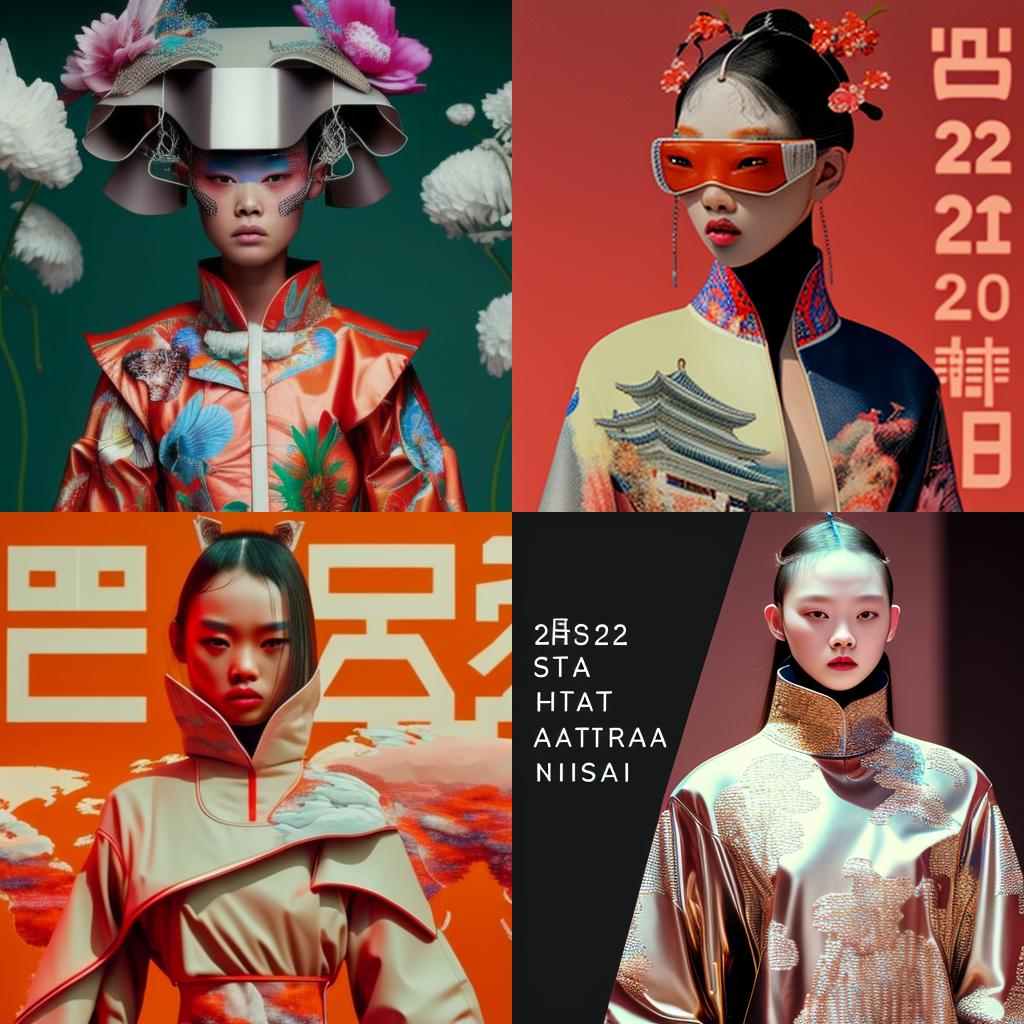China Fashion in 2023: Sustainability, Technology & Rise of Metaverse

#1 Sustainability efforts and eco-friendliness initiatives in the Chinese fashion industry
Recent years have witnessed the awareness awakening of Chinese consumers for sustainability. It has been mainstream for players in the Chinese market to have a mention in sustainable development, according to a Roland Berger report. Over 85% of 1000 participants in the survey, or mostly the young Millennials and Gen Zers, believe fashion consumerism has a negative impact on the environment. A shift in perspectives cannot be separated from a change in consumer behaviors. The same study reveals that approximately 80% of consumers will avoid plastic-based materials, such as nylon and polyester, when purchasing fashion pieces. And more than half of survey respondents have bought secondhand or organic material items in the past two years.
China's political initiatives and regulations are also shaping the fashion industry value chain. In September 2020, the country updated its pledge to peak carbon emissions by 2030 and achieve carbon neutrality by 2060. China National Textile and Apparel Council (or CNTAC), the industry leader in fashion, has issued guidance in recent years to help reduce emissions and empower fashion entities to innovate for sustainability.
China fashion industry trends on sustainable development
- Environment-friendly materials are gaining favor among consumers.
Fashion businesses are investing in the R&D of new materials, aiming to reduce their reliance on fossil fuel-based and virgin materials. In the meantime, consumers are paying increased attention to recycled, organic fibers or plant-based dyes.
- Traceability and visibility: digitalization empowered supply chain.
The financial think tank Planet Tracker asserts that traceability in the supply chain, once realized, will not only bring the sustainable reform in fashion a big leap forward but also become the next net profit growth point and introduce new financing opportunities by building trust between business owners and stakeholders.
- A growing focus on recycled fashion
Fashion giants H&M and Uniqlo both launched projects for clothing recycling in China. As of 2020, H&M has recycled more than 2525 tons of textiles in China's mainland. Inman (茵曼), a top-selling Chinese clothing brand, has launched recycling points in over 500 brick-and-mortar stores in collaboration with Feimayi (飞蚂蚁, meaning Flying Ant), a clothing recycling platform.
- Multi-channel communications
Brand and consumer communications will be increasingly diverse, reflecting new consumer preferences development. Millennials and Gen Zers, for instance, prefer online channels to get sustainability information about a fashion item. Gen Zers have a particular focus on the creativity of brands' online content. Furthermore, interactive experience, community sharing, and concept stores are becoming the main mechanisms of promoting sustainable fashion.
- Supporting sustainability services is getting better.
Along the sustainable fashion trend comes consumer interest in apparel maintenance and repair. According to Worldwide Responsible Accredited Production (or WRAP), each clothing item could reduce 4~10% emissions in carbon, water, and waste if their longevity is nine months longer. It is a standard practice for high-end brands to offer in-house repair services. A growing number of self-claimed sustainable brands are chasing up fast in this.
Under increasing interest from investors, consumers, and regulators, sustainability will most certainly emerge as the locus for development, opportunities, and prospects of China's fashion industry.
#2 NFTs
Like every other sector, the fashion industry has been setting foot into the digital era in recent years. New trends in technology, such as NFT, metaverse, and Web 3.0, are getting the fashion industry excited. The past year has saw NFT+ attempts from household brands like Nike, Gucci, and Burberry, unfolding a promising prospectus.
The NFT-enhanced fashion trend is now literally sweeping in China. Local brands such as Li-Ning (李宁), Ellasay (歌力思) and e-commerce platforms such as Alibaba are outlining the metaverse landscape of this industry. 2022 may mark the beginning of China's fashion metaverse.
Types of NFT fashions
First, there are RTFKT, the biggest brands in the NFT market, and Bored Ape Yacht Club (BAYC), which introduce you to virtual products and experiences.
Then, there are emerging digital fashion presences such as The Fabricant Studio, which aims to create the wardrobe of the metaverse.
In addition, various fashion brands are also trying different ways of embracing NFTs, including creating virtual garments that can be worn within virtual environments, digital content that owners can interact with, and even digital twins of physical creations. For example, Gucci Aria, a video launched in honor of the brand’s 100th anniversary in May 2021, was sold for a staggering $25,000, becoming the first luxury brand to dive into NFT.
China is witnessing a diverse coupling between NFT and fashion, from the NFT IP-inspired fashion collaborations to the partnerships between fashion brands and emerging virtual brands.
Chinese brand Li-Ning has taken as its mission to combine sports and pop culture, with a keen interest in linking Chinese culture to pop culture. This brand has made several attempts in NFT in the past years. In April 2022, Li-Ning launched a collaboration line with BAYC, the most talked about IP in NFT. BAYC 4102 has been appointed as the manager of Li-Ning's pop-up fashion store. This marketing campaign, featuring creative online and offline content, has made NFT more approachable to the general public. By doing so, Li-Ning has built a brand that finds favor with the younger generation of consumers.
Ellassay is another Chinese brand that pioneered testing the waters of NFT. The year 2020 marks the start of the brand's digital journey. It launched a CGI-powered virtual character Elisa for its 2020 Spring/Summer campaign. The following year, the brand introduced an immersive show experience with a 360-degree dome camera.
Independent designer brands, attracted by the freedom offered by NFT in creative expression, signed themselves up for the game too. Sfaffonly, a Chinese menswear designer brand, launched a series of virtual characters for its online NFT auction platform, which incorporates the concept of NFT into its design for the new season.
The Chinese E-commerce giant Alibaba also deserves a mention for its many attempts to combine NFT with fashion. Its Metaverse Art Exhibition, which created a pathway between its shopping spree festival on 11th November and the digital world, showcased digital collectibles by such high-end brands as Qeelin, Breitling, Panerai, Piaget, and Burberry.
As we can see, the Chinese fashion industry has set foot on the journey to explore Web 3.0. A good example is Li-Ning's collaboration with BAYC, which exhibits how IP authorization could happen in a new scenario. NFT will likely be a key growth sector for the Chinese fashion industry in 2023.
#3 Phygital Fashion
Phygital, a combination of physical and digital, is the marketing buzzword for 2022. It focuses on the immediate, interactive, and immersive consumer experience that blends the physical and the digital spaces.
It has to be emphasized that not all digital marketing that interacts with the real world can be tagged as phygital. Its essence lies in real-time interaction. It blurs the border between the real and the virtual worlds, allowing consumers a seamless shift between the spaces for convenient services and immersive experiences.
Phygital won its place among the 2022 fashion buzzwords through such features as immediacy, interaction, immersion, and seamless online and offline shifting.
The mix of phygital and fashion can only come to be with the development of the metaverse. Kivisense, China’s one-stop WebAR solution provider, empowers fashion brands in digital transformation. Its AR try-on solution features high-accuracy body movement tracking, high-performance 3D rendering, and a physical engine for try-on experience simulation. They work together to offer consumers a brick & mortar store experience and reduce online sales' return rate. Kivisense supports the virtual try-on application for such scenarios as trying clothing, bags, and wearable NFTs.
For the Millennials and Gen Zers, who are becoming the majority of consumers in China, the borderline between virtual and real is vanishing. It is concluded that 82% of young consumers particularly like personalized shopping that integrates online and offline experiences.
According to PwC's 2021 Global Consumer Insights Survey China Report survey, 53% of Chinese consumers maintained a daily or weekly visit to brick-and-mortar stores. This reveals the significance of physical stores in China despite the backdrop of an increase in the consumer choice of shopping online. The report also points out that 51% of Chinese consumers prioritize such physical store features as "the ability to see and touch the products" and “the ability to quickly and conveniently navigate the store to find products of interest."
The space for phygital development is huge since the bricks-and-clicks experience falls in the more positive spectrum of consumer expectations.
#4 Streetwear and athleisure
Recent years have seen an upsurge in per capita consumption of sportswear, thanks to the increase in Chinese consumers' disposable income, their increasing awareness of the importance of doing sports, and the consumption update in lower-tiered cities. Athleisure sportswear received a huge welcome in China. Gym ceases to be the only proper occasion for such clothing, as consumers seek better looks from sportswear to extend their feasibility as daily wear. A pair of leggings, for example, is more than a piece for yoga. They are also worn in daily life and social events. Lululemon and Particle Fever are representatives of popular athleisure brands in China.
Another point to note, China has experienced an exponential growth of interest in hip-hop among the Millennials and Gen Zers. Streetwear is immediately taken by young consumers to brand their individuality. Oversized hoodies and sweatpants, in particular, become their go-to choice for street styles.
#5 Guochao
A growing number of young consumers are showing affection for Guochao (国潮), a fashion trend that could be translated into 'China-chic'. According to a Xinhuanet report, Gen Z contributed a staggering 74% to the sales of local Chinese fashion brands. The statistics from Dewu, a rising fashion e-commerce app, show that the year 2020 has witnessed a 10-fold increase in Guochao consumption among its young users. It is common for some chic local brands or fashion pieces featuring Chinese culture to be eagerly sought-after in recent years. The Guochao trend has swept through the young consumer market in just a link.
China is the new frontier in the fashion industry, and brands are scrambling to break into what could be a massively lucrative market. The biggest challenges? Understanding how the above trends will transform the industry, what new opportunities they will bring to the brands, and how to keep up with the ever-growing trends and opportunities. We've gone ahead and dissected these fashion trends and practices in China so we can help you prepare for your winning future in the Chinese fashion market.
If you are in the fashion industry and want to thrive in the Chinese market, contact Duhno
We also have a webinar regarding that topic, you can watch the webinar replay here:
